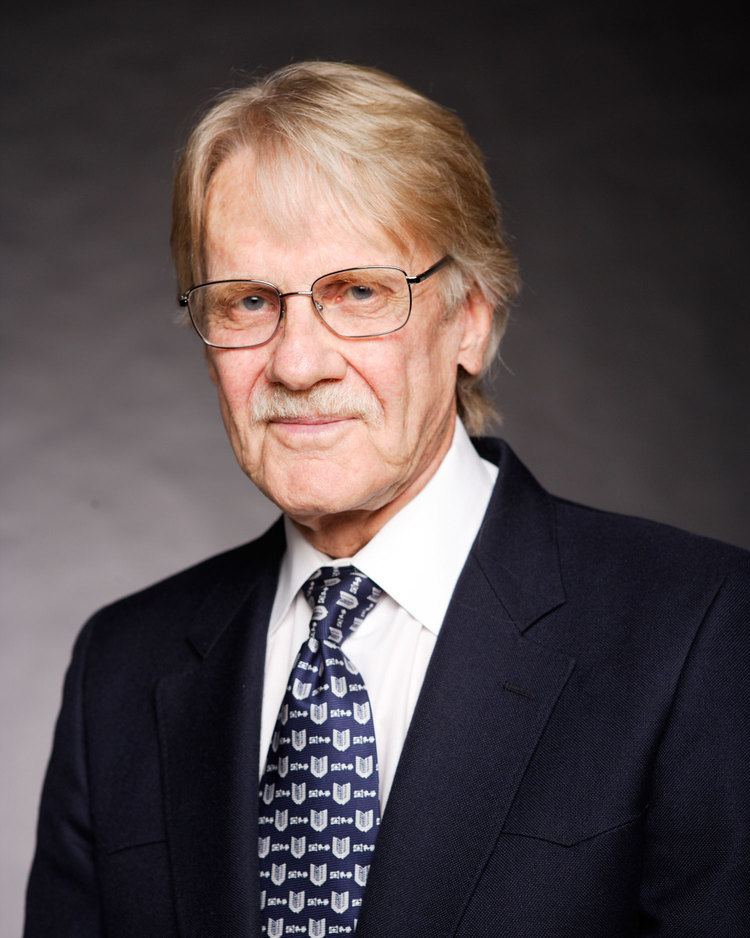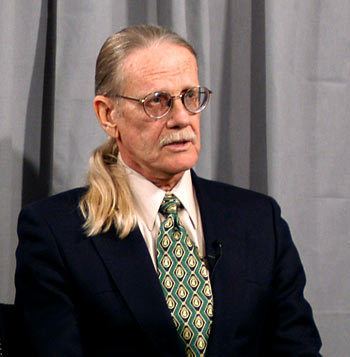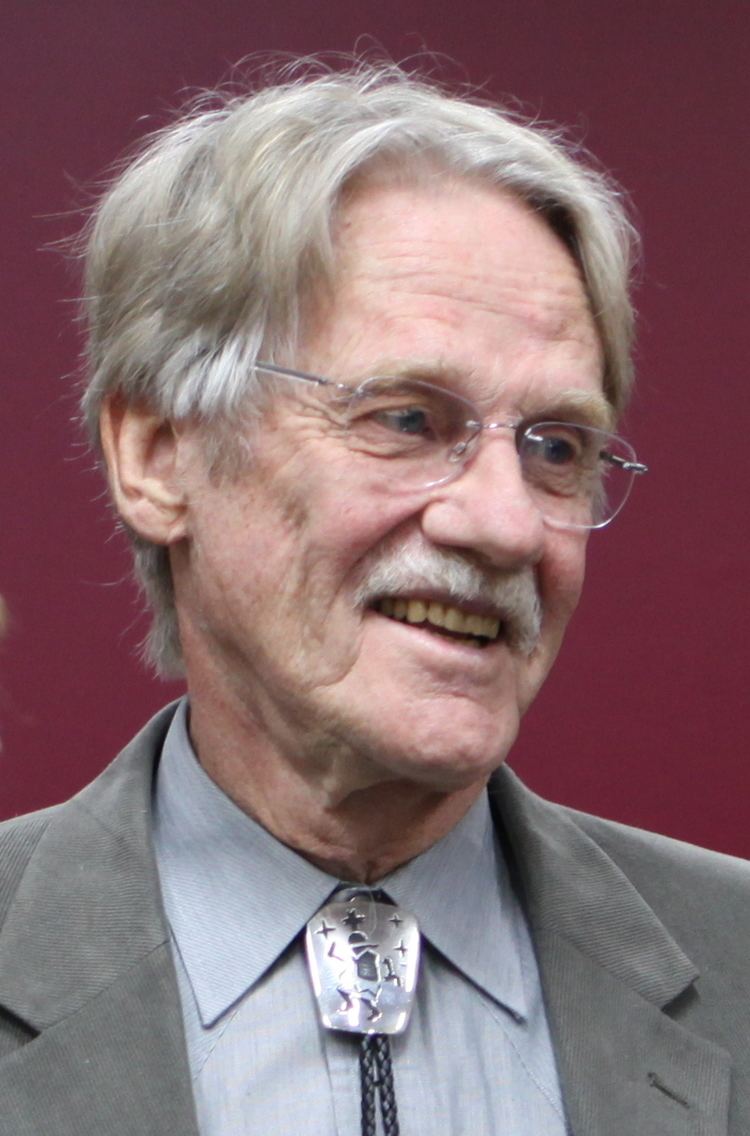Nationality United States Fields Experimental economics | Role Professor Name Vernon Smith | |
 | ||
School or tradition New classical economics Influences Leontief, Hayek, Richard S Howey Contributions Combinatorial auctionExperimental economics Education Harvard University, University of Kansas, Wichita North High School, California Institute of Technology Books Rationality in Economic, Discovery ‑ A Memoir, Bargaining and Market Behavior, Investment and production, Papers in Experimental Economics Similar People Friedrich Hayek, Francesco Parisi, Wassily Leontief, James M Buchanan, John A List | ||
Academic advisor Wassily Leontief | ||
Prof. Vernon Smith (2002 Nobel Laureate in Economics) lecture at CERGE-EI, February 2010
Vernon Lomax Smith (born January 1, 1927) is an American professor of economics at Chapman University's Argyros School of Business and Economics and School of Law in Orange, California, formerly a research scholar at George Mason University Interdisciplinary Center for Economic Science, and a Fellow of the Mercatus Center, all in Arlington, Virginia.
Contents
- Prof Vernon Smith 2002 Nobel Laureate in Economics lecture at CERGE EI February 2010
- Dr vernon l smith adam smith and his significance for economic trust games
- Education
- Academic career
- Works
- References

Smith shared the 2002 Nobel Memorial Prize in Economic Sciences with Daniel Kahneman.

Smith is the founder and president of the International Foundation for Research in Experimental Economics, a Member of the Board of Advisors for The Independent Institute, and a Senior Fellow at the Cato Institute in Washington D.C. In 2004 Smith was honored with an honorary doctoral degree at Universidad Francisco Marroquín, the institution that named the Vernon Smith Center for Experimental Economics Research after him.
Dr vernon l smith adam smith and his significance for economic trust games
Education
Smith was born in Wichita, Kansas, where he attended Wichita North High School and Friends University. He received his bachelor's degree in electrical engineering from Caltech in 1949, an M.A. in economics from the University of Kansas in 1952, and his Ph.D. in economics from Harvard University in 1955.
Academic career
Smith's first teaching post was at the Krannert School of Management, Purdue University, which he held from 1955 until 1967, attaining the rank of full professor. It was there that his work in experimental economics began. As Smith describes it:
In the Autumn semester, 1955, I taught Principles of Economics, and found it a challenge to convey basic microeconomic theory to students. Why/how could any market approximate a competitive equilibrium? I resolved that on the first day of class the following semester, I would try running a market experiment that would give the students an opportunity to experience an actual market, and me the opportunity to observe one in which I knew, but they did not know what were the alleged driving conditions of supply and demand in that market.
In framing the experiment, Smith varied certain institutional parameters seen in the first classroom economics experiments as conducted by Edward Chamberlin: in particular, he ran the experiments for several trading periods, to give the student subjects time to train.
Smith also taught as a visiting associate professor at Stanford University (1961–1962) and there made contact with Sidney Siegel, who was also doing work in experimental economics. Smith moved with his family to Massachusetts and got a position first at Brown University (1967–1968) and then at the University of Massachusetts (1968–1972). Smith also received appointments at the Center for Advanced Study in the Behavioral Sciences (1972–1973) and Caltech (1973–1975). At Caltech, Charlie Plott encouraged Smith to formalize the methodology of experimental economics, which he did in two articles. In 1976, "Experimental Economics: Induced Value Theory" was published in the American Economic Review (AER). It was the first articulation of the principle behind economic experiments. Six years later, these principles were expanded in "Microeconomic Systems as an Experimental Science," also in the AER. This paper neatly adapts the principles of a microeconomic system developed by Leonid Hurwicz, a recent winner of the Nobel Memorial Prize in Economic Sciences, to the development of economic experiments. In Hurwicz's formulation, a microeconomic system consists of an economic environment, an economic institution (or economic mechanism), and an economic outcome. The economic environment is simply the preferences of the people in the economy and the production capabilities of the firms in the economy. The key insight in this formulation is that the economic outcome can be affected by the economic institution. The mechanism design provides a formal means for tests of the performance of an economic institution, and experimental economics, as developed by Smith, provided a means for formal empirical assessment of the performance of economic institutions. There is a second key contribution of his influential paper "Microeconomic Systems as an Experimental Science," but it goes beyond adaptation of the concepts of mechanism design developed by Hurwicz. In his paper, Smith describes the technique of induced values, the method used in controlled laboratory experiments in economics, political science, and psychology. This technique is what allows experimental economists to create a replica of a market in a laboratory. Subjects in an experiment are told that they can produce a "commodity" at a cost and then sell it to buyers. The seller earns the difference between the price received and its cost. Buyers are told that the commodity has a value to them when they consume it, and they earn the difference between the value of the commodity to them and its price. Using the technique, Smith and his coauthors have examined the performance of alternative trading mechanisms in resource allocation.
Much of the research that earned Smith the Nobel Memorial Prize in Economic Sciences was conducted at the University of Arizona between 1976 and 2001. In 2001, Smith left Arizona for George Mason University. From 2003 to 2006, he held the Rasmuson Chair of Economics at the University of Alaska Anchorage. In 2008, Smith founded the Economic Science Institute at Chapman University in Orange, California. In February 2011, Smith participated in the "Visiting Scholars Series" at the Nicholas Academic Centers in Santa Ana, California, conducted in collaboration with Chapman University. Smith and his colleague Bart Wilson conducted experiments designed to expose high school students from underserved neighborhoods to market dynamics and how concepts such as altruism influence economic behavior. The Nicholas Academic Centers conduct afterschool tutoring and mentoring programs, which, in three years, have helped more than 100 graduating seniors gain admission to top US colleges and universities.
Smith has authored or coauthored over 200 articles and books on capital theory, finance, natural resource economics and experimental economics. He was also one of the first to propose combinatorial auction, with Stephen J. Rassenti and Robert L. Bulfin in 1982.
Smith serves or has served on the board of editors of the American Economic Review, The Cato Journal, Journal of Economic Behavior and Organization, the Journal of Risk and Uncertainty, Science, Economic Theory, Economic Design, Games and Economic Behavior, Journal of Behavioral Finance and the Journal of Economic Methodology. He also served as an expert for the Copenhagen Consensus.
Smith's papers have been published by Cambridge University Press: Papers in Experimental Economics (1991) and Bargaining and Market Behavior: Essays in Experimental Economics (2000).
A collection of Smith's papers is housed at the Rubenstein Library at Duke University.
In February 2005, Smith publicly attributed features of his personality to Asperger's syndrome after a process of self-diagnosis.
In January 2009, Smith signed a public petition opposing the passage of the American Recovery and Reinvestment Act. In a 2010 Econ Journal Watch study, Smith was found to be one of the most active petition-signers among US economists.
In 2012, he co-authored the chapter, 'At Home in the Great Recession', in The 4% Solution: Unleashing the Economic Growth America Needs, published by the George W. Bush Presidential Center.
In 2014, Cambridge University Press published Rethinking Housing Bubbles, which examines the housing and mortgage bubble between 2001 and 2007 and the financial crisis that followed it, in 2008.
The Vernon Smith Prize for the Advancement of Austrian Economics is named after him and is sponsored by the European Center of Austrian Economics.
